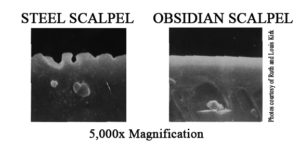
The first archaeological evidence known of usage were made from within Kariandusi and other sites of the Acheulian age (beginning 1.5 million years previously) dated 700,000 BC, although the number of objects found at these sites were very low relative to the Neolithic. Acigöl town and the Göllü Dað volcano were the most important sources in central Anatolia, one of the more important source areas in prehistoric Near East. Ancient sources in the Aegean were Melos and Giali.

There are only four major deposit areas in the central Mediterranean: Lipari, Pantelleria, Palmarola and Monte Arci. states of Virginia, as well as Pennsylvania.

Obsidian can also be found in the eastern U.S. states including Arizona, Colorado, New Mexico, Texas, Utah, Washington, Oregon and Idaho. Yellowstone National Park has a mountainside containing obsidian located between Mammoth Hot Springs and the Norris Geyser Basin, and deposits can be found in many other western U.S. Obsidian flows which may be hiked on are found within the calderas of Newberry Volcano and Medicine Lake Volcano in the Cascade Range of western North America, and at Inyo Craters east of the Sierra Nevada in California. It can be found in Argentina,Armenia, Azerbaijan, Canada, Chile, Georgia, Greece, El Salvador, Guatemala, Iceland, Italy, Japan, Kenya, Mexico, New Zealand, Peru, Scotland, Turkey and the United States. Obsidian can be found in locations which have experienced rhyolitic eruptions. Pig carved in snowflake obsidian, 10 centimeters (4 in) long. This breakdown of obsidian is accelerated by the presence of water. Because obsidian is metastable at the Earth’s surface (over time the glass becomes fine-grained mineral crystals), no obsidian has been found that is older than Cretaceous age. Crystalline rocks with obsidian’s composition include granite and rhyolite. Obsidian consists mainly of SiO2 (silicon dioxide), usually 70% or more. Though obsidian is usually dark in color similar to mafic rocks such as basalt, obsidian’s composition is extremely felsic. It is sometimes classified as a mineraloid. Obsidian is mineral-like, but not a true mineral because as a glass it is not crystalline in addition, its composition is too complex to comprise a single mineral. Tektites were once thought by many to be obsidian produced by lunar volcanic eruptions, though few scientists now adhere to this hypothesis. Having a low water content when newly formed typically less than 1% water by weight, becomes progressively hydrated when exposed to groundwater, forming perlite. Obsidian is the rock formed as a result of cooled lava, which is the parent material. it is found in volcanic areas or areas were volcanism has occurred sometime in Earth’s history.A baroque cabochon of iridescent “rainbow obsidian”.

The fine-grain is due to quick cooling magma. Obsidian under the microscope showing a complex fine-grained texture. Another benefit to using obsidian scalpels is the reduction of healing time for surgical incisions. Given these unique characteristics a German company has created surgical tools that allow doctors to use obsidian instruments on patients who might be allergic to steel. It is 3 times sharper than diamond and between 500-1000 times sharper than a razor or a surgeon’s steel blade resulting in easier incisions and fewer microscopic ragged tissue cuts. Surprisingly, the edge of a piece of obsidian is superior to that of a surgeon’s steel scalpel. Because of its sharp edges early man used it to make cutting tools or arrowheads.

Obsidian has a conchoidal (shell-like pattern) fracture, which means that it breaks like glass and does not form any flat crystal facets. Obsidian is considered more of an igneous rock than a mineral, since glass does not have the crystal structure that defines minerals. Obsidian hand sample showing the glassy texture. The result is a silicon dioxide glass with magnesium and iron to give it the dark color. Obsidian is a volcanic glass created when magma is extruded from a volcano and quickly becomes quenched (cooled) so that crystals have almost no time to grow. Today’s featured rock/mineral piece is on: Obsidian.


 0 kommentar(er)
0 kommentar(er)
